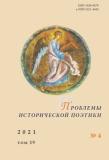Мотив искушения в древнерусском апокрифе «Хождение Зосимы к рахманам»
The Temptation Motif in the Old Russian Apocrypha Zosima’s Journey to the Rahmans
Author(s): Irina V. FedorovaSubject(s): Russian Literature, Eastern Slavic Languages, Biblical studies, Philology, Hermeneutics, Theory of Literature
Published by: Петрозаводский государственный университет
Keywords: motif; apocryphal; Zosima’s Journey; earthly paradise; Rechabites; blessed; temptation; edition; text structure;
Summary/Abstract: The article examines the functioning of the temptation motif in the ancient Russian apocrypha Zosima’s Journey to the Rahmans. The methods of implementing this motif in the text are analyzed; its significance in the plot of the work and in the formation of the image of the earthly paradise, with which the country of the blessed is associated in this literary work, is established. The biblical source of the motif is the Old Testament story of the fall of Adam and Eve and the test of the strength of faith, embodied in the temptation of Jesus Christ by the devil in the desert. The heterogenous structure of Zosima’s Journey to the Rahmans, where independent plots are integrated (the legendary story of the Rekhabites and the description of the land of the blessed), determined the varied realizations of the motif temptation in the text. An analysis revealed that the prologue of the literary work already contains an allusion to the Gospel temptation plot (a report of the forty-day prayer of the hermit to God). In the story of the Rechabites’ opposition to the king of Jerusalem and the story of the confrontation between Zosima and the devil, the motif of temptation is a plotforming one. The story of the hermit’s temptation is formed by two storylines: Zosima’s opposition to the devil and the fall of the first people, told by the tempter to intimidate the hermit. The Old Testament sin of Adam was developed in the storyline of Zosima and the Rechabite elder, who denounced the hermit as a «preacher» who involuntarily tried to persuade him to lie. The motif of temptation in Zosima’s Journey to the Rahmans may have been expressed explicitly, or merely be discernible, as in the story about the observance of Great Lent by the blessed or through the symbolic connotation of the numbers used in the literary work. The article also demonstrates that changes in the literary history of the apocrypha were reflected in the implementation of the temptation motif in its text.
Journal: Проблемы исторической поэтики
- Issue Year: 19/2021
- Issue No: 4
- Page Range: 149-170
- Page Count: 22
- Language: Russian

